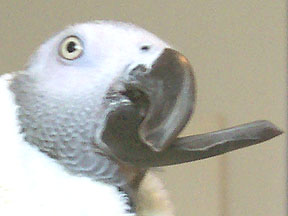One of my fairly regular patients is a blue and gold macaw with a deviated beak. This is commonly called "scissor beak" and happens most commonly in larger parrot species. At some point when they are young, part of the beak grows abnormally, pushing the beak away from the normal middle position. Over time this becomes worse and worse as the normal wearing of the beak happens abnormally as the upper and lower portions do not meet up properly. Improper beak shape can lead to difficulty eating as the bird cannot grab its food properly. Here's an example of what this can look like.
In mild or early cases an experienced avian vet can reshape the beak with a Dremmel hand tool, wearing down the long portions to a more normal position. Though somewhat distressing to the bird, this is actually a painless procedure. However, when the problem continues for long enough even regular trimming won't be a final solution. In these cases surgery may be needed for a permanent fix. Another method is to use acrylic on the beak to gradually force the beak into a normal position. Once normal positioning is achieved, the shape should be self-sustaining over time.
The macaw I see, Alex, has been coming to me for over a year now, and he's only three. Though I'm good with birds and other exotics, I'm not a specialist and have been trying to get the owner to go to a local board-certified avian vet to have more advanced procedures done. Alex has a lifespan comparable to a human, so taking care of this now will help give him a better life in the future.
If anyone knows someone who has a bird with a beak growing like this, make sure they see someone skilled in avian medicine right away. The earlier that treatment starts, the more successful it can be.
